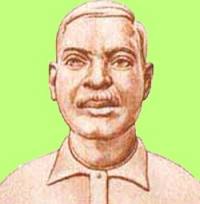
Tribal resistance movement was an integral part of freedom struggle and the
heroic role played by many distinguished tribal leaders. They had identified
themselves with the mainstream freedom struggle against heavy odds and at the
cost of their lives and princely career. Laxman Naik of Koraput is one of them.
There is a long and illustrious list of tribal resistance movement took place in
different parts of Orissa. But nothing could be more inspiring and edifying than
the saga of heroic struggle and sacrifice of one single tribal leader of Koraput
whose feats and exploits till today are unparallel.
This great man
is no other than Laxman Naik of Koraput District. Laxman Naik was born on 22nd
November, 1899 in Tentuligumma of Malkangiri. His father was Padlam Naik. He
belonged to a Bhuyan tribe. He fought single handed against the oppressive
foreign rulers with consummate skill and a rare passion and fervour of a
fighter. He was the very fountain of grit, courage and strength to countless
followers and co-workers and shone by rare brilliance. He stood up like a rock
with only one supreme truth as his polestar, the freedom of his mother land.
He sacrificed all his creature comforts and ultimately consumed himself but did
not break or bend a bit before the wily machination of the foreign usurpers.
This innocent tribal hero Laxman Naik was attracted towards the National
Movement, when the message of Congress Movement reached Koraput. He became an
active member of the Congress in enrolling as charanna member of the Indian
Natinal Congress. He received all kinds of physical education and learnt about
national integration. He organized the tribal people to fight against old and
inhuman practices like bonded labour. He played a key role to popularize
Congress programme in Koraput.
The tribal people of Koraput and its
surrounding like Malkanagiri, Tentulipada accepted him as their hero and devoted
themselves for the cause of national freedom. He promoted ‘Khadi’ and made
people aware of the Congress plan of action. He tried to inculcate a sense of
unity among people for the freedom. The subaltern perception of people’s
participation found its subtle manifestation in this part who fought for
freedom. It was more insistent in case of the illiterate villagers than that of
the elitists of town. The mass participation of tribals in this area took a new
dimension in the Congress movement after congress formed ministry in 1937. They
get a sense of fresh courage which led to some minor incident of rioting.
The best example is killing of a sub-inspector with an axe when he removed a
Congress flag while hoisting. Violence in a nonviolent movement like Indian
National Movement could be seen from such incidents. Laxman Naik took the charge
of President of the Congress primary committee at Matili in Koraput in 1942. He
managed to mobilise the tribal people for various development works like
construction of roads, building bridges and establishing schools. He asked the
villagers not to pay any tax. He spearheaded the fight against oppression,
sufferings and exploitation. During the Quit India Movement 1942, Laxman Naik
was nominated to represent Matili. He used nonviolence as a main weapon against
colonial power. The tribal people called him “Gandhi of Malkangiri. The tribal
movement created an unprecedented public awakening in Koraput.
The
message of Quit India Movement was circulated in the whole of Koraput. The Bonda
tribes of this region were violent and belligerent and seized Matili police
station under the leadership of Laxman Naik. In 1942, August, Laxman Naik and
Congress workers attacked liquor shop at Kongrabeda, Muntipalli, Sindhabeda. He
led a long procession to Matili police station. It was on August 21, 1942,
tribals from different villages moved towards matili, holding a Congress flag
and chanted ‘Ramdhun’ and proceeded towards police station. They entered the
compound of police station and tried to hoist the flag at the top of the Police
Station. Laxman Naik was not allowed to hoist flag, as the magistrate Mujibur
Rahman ordered ‘Lathi’ charge on the demonstrators. The angry demonstrators gave
patriotic slogans. Two police officials Ram Murty and constable Mohanty were
injured.
As the police opened firing, 5 died on spot and 17 injured.
The injured Laxman was thrown into the ditch near the compound. It was a
blessing in disguise for the police to involve Laxman in a murder case of forest
guard G. Rammaya. He along with his son and other Congress workers were arrested
at Matili police station and were sent to Koraput jail. The trial of Laxman Naik
was made at the Additional session court of Koraput. V.Ramnathan, the Additional
Session judge, Koraput sentenced Laxman Naik to death under section 302 of IPS.
He was then sent to Berhampur Jail for execution.
Laxman Naik was in
the cell since November 16,1942. When his execution date drew nearer, he wished
to see his fellow prisoners and eat what they were given. All the inmates of
Berhampur jail offered prayer. His fellow prisoners wept throughout night of
March 28,1943. At the break of dawn on March 29, 1943 by 5.30 a.m., Laxman Naik
gallantly marched towards the Gallows. He wished his last. ”If the sun is true,
and so is the moon, it is then equally true that mother India shall be
independent.” Rammurty, the Zamadar of jail pulled the lever bringing the iron
plate under his feet down. There ended his life, and he was buried inside the
jail compound. Though Laxman Naik did not live to see free India, he remained
imprinted in the minds of millions of people of India as the leader of leaders.
|